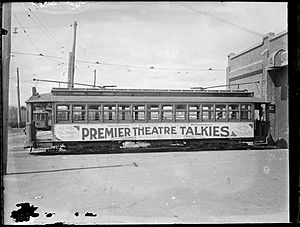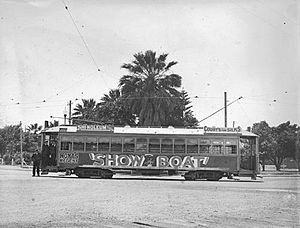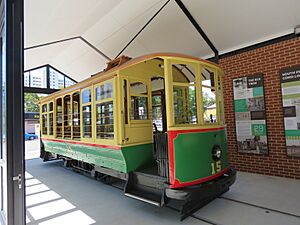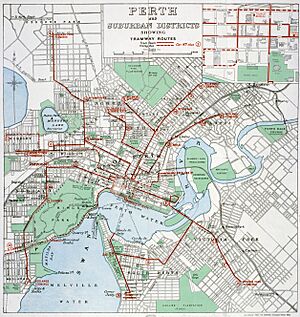Trams in Perth facts for kids
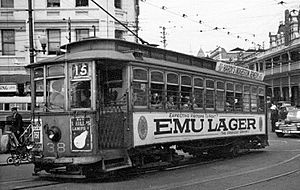
Tram 38 on Horseshoe Bridge, 1950
|
|
| Operation | |
|---|---|
| Locale | Perth, Western Australia |
| Open | 28 September 1899 |
| Close | 19 July 1958 |
| Status | Closed |
| Owner(s) |
|
| Operator(s) |
|
| Infrastructure | |
| Track gauge | 3 ft 6 in (1,067 mm) |
| Propulsion system(s) | Electricity |
| Electrification | Overhead catenary |
| Depot(s) | East Perth |
| Statistics | |
| Route length | Over 50 km (31 mi) (max) |
The Perth tramway network was a system of trams that helped people travel around Perth, the main city in Western Australia. It ran from 1899 until 1958.
At first, a private company owned and ran the trams. But in 1913, the state government took over. The network started with just one line on Hay Street. It grew to cover many areas. Trams went north to Osborne Park, east to Welshpool, south to Como, and west to Claremont. After World War II, buses slowly replaced the trams.
The nearby city of Fremantle had its own tram system. It was separate and not connected to Perth's network.
Contents
History of Perth Trams
Early Horse Tram Ideas
Some people thought there was a horse tram for passengers in Perth. This tram was believed to run from the General Post Office to East Perth. However, it now seems that this passenger horse tram never actually existed.
Instead, there was likely a horse tramway used for building. This tramway carried stones from quarries north of the city. It took them to the construction site of Government House. We don't know exactly how long this tramway was used. We also don't know its exact route. Research is still ongoing to find more information. We do know that horse-drawn buses were used for transport.
The Rise of Electric Trams
The first electric tram system in Perth was started by an English company. It was called Perth Electric Tramways Limited. Building the lines began on January 30, 1899. Trams started running on September 28, 1899.
The very first line was 4.8 kilometers long. It ran along Hay Street. It went from East Perth, near the WACA Ground, to Thomas Street in West Perth. There was also a short side line to Kings Park.
More tram lines soon opened up. These new lines connected different parts of Perth. Some of the early areas connected included:
- Subiaco
- Nedlands
- Wellington Street East
- Mounts Bay Road
- Mount Lawley
- Victoria Park
- North Perth
- Leederville
- Osborne Park
By June 1913, the tram network was 37 kilometers long. There were 53 trams in total. Most were smaller four-wheel trams. Nine were larger, bogie cars.
Government Takes Over
The Perth City Council had the right to take over the tramways. This was part of the original agreement with the private company. However, the state government decided to buy the network instead. They passed a law called the Tramways Purchase Act 1912.
The government took over the Nedlands line on May 29, 1913. The rest of the lines followed on July 1, 1913. The Osborne Park line was taken over in December 1914.
The Western Australian Government Railways (WAGR) ran the tram network for many years. In April 1949, a new department was created. It was called the Western Australian Government Tramways & Ferries. This new group then managed the trams.
Network Expands and Closes
As Perth grew, so did the tram network. More lines opened between 1913 and 1930. These included lines to:
Some older lines were closed in the 1920s and 1930s. For example, the line to Kings Park Road closed in 1930. In the 1930s, a few more extensions opened. These included lines to Salisbury Street in Inglewood and Patricia Street in Victoria Park. The Wembley line also got an extension.
Some tram services were replaced by trolleybuses. This happened for the Wellington Street East, Claremont, and Wembley lines.
In the early 1940s, the very last extensions were built. The Inglewood line was extended by 400 meters. It reached Grand Promenade. The Victoria Park line was extended by 1.6 kilometers. This helped serve a factory at Welshpool.
Starting in 1948, all the tram lines were slowly replaced by buses. This process took about ten years. The very last tram in Perth ran on July 19, 1958.
Perth Tram Rolling Stock
Over the years, 130 different trams were used in Perth. The first trams were made by companies in the United States. These included J. G. Brill Company and St. Louis Car Company. Later trams were built locally. They were made at the WAGR's Midland Railway Workshops.
The trams were first painted a bright red color. In 1903, a darker red was used. Later, they changed to a WAGR red with gold lines. In 1927, the trams became light grey. In the 1930s, they were painted cream and green. This was the same color scheme as the trolleybuses.
Some of the old Perth trams have been saved. They are now kept by the Perth Electric Tramway Society. You can see them at their heritage tramway in Whiteman Park. This park is in Caversham, a suburb of Perth.
Tram Patronage
Patronage means the number of people who used the trams. The table below shows how many passengers rode the Perth trams each year. You can see how popular they were.
| Perth tram patronage | ||
|---|---|---|
| FY | Patronage | ±% p.a. |
| 1900 | 4,000,000 | — |
| 1910 | 6,800,000 | +5.45% |
| 1920 | 18,900,000 | +10.76% |
| 1930 | 34,900,000 | +6.33% |
| 1940 | 31,900,000 | −0.89% |
| 1945 | 50,400,000 | +9.58% |
| 1950 | 35,400,000 | −6.82% |
| 1960 | 0 | −100.00% |
| Source: Bureau of Infrastructure & Transport Research Economics | ||



